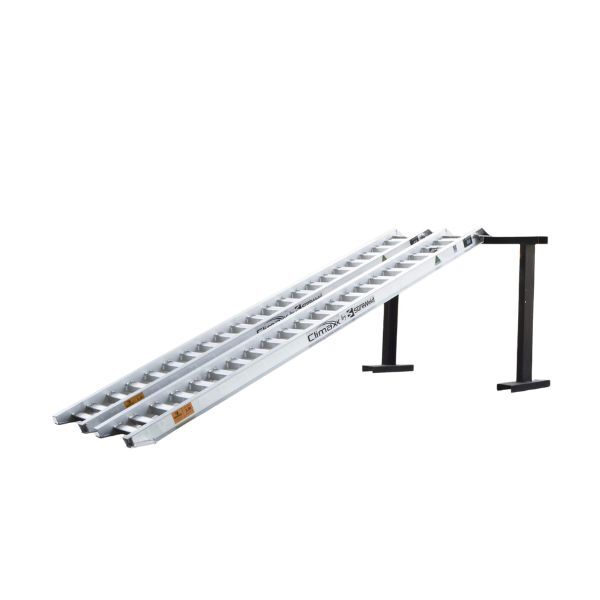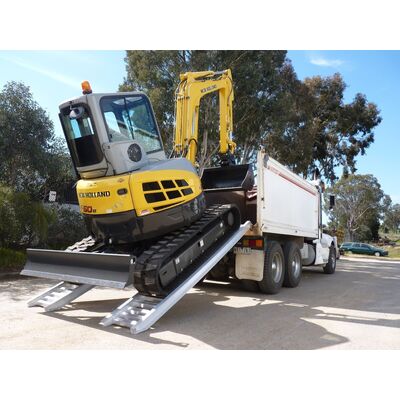Are you new to loading ramps and have no idea where to get started? We’ve got you covered. It can be intimidating to buy a loading ramp, especially when you have no idea what you need. We’re here to guide you through the process and help you decide which loading ramp would be best suited for you and your machinery!
Why You Need a Loading Ramp
It goes without saying that the best way to load gear is to use a good quality loading ramp. It mostly comes in handy in workplaces or areas where you will be required to regularly transport heavy and large machinery from one place to another. It is a quality investment that can save you a lot of time and make the task a lot more efficient. Plus, it can help you avoid damage to your expensive equipment and machinery!
How to Choose the Right Loading Ramp
While there are a huge variety of loading ramps around, not all will be suitable for your needs. Your challenge is to figure out what type of ramp you need. But you won’t be on your own! We’ll guide you through it so you can make an informed choice.
Ramp Weight Limit
Ramp capacity is possibly the biggest factor for your purchase. The weight capacity of your ramp should suit what you’re intending to transport. We stock ramps that can handle anywhere between 1500–3600 kg. When calculating how strong aluminium loading ramps are and the size of ramp you will require, be sure to take into account important factors, such as how heavy your machinery is and don’t forget to include the wet weight — any fluids like engine oil and gear oil — along with any attachments too and, of course, the driver. To be on the safe side, look for a ramp that will handle the heaviest possible combination you are likely to use.
Ramp Material
 Apart from weight capacity, another important factor to consider is the material of the ramp. The two major materials that loading ramps come in are aluminium and steel. The best way to choose which material you need is to consider the environment you work in.
Apart from weight capacity, another important factor to consider is the material of the ramp. The two major materials that loading ramps come in are aluminium and steel. The best way to choose which material you need is to consider the environment you work in.
While both aluminium and steel loading ramps are strong and durable, there are some other aspects of these materials to think about. For instance, steel loading ramps tend to be the more cost effective option. However, aluminum loading ramps can often be the safer choice, as steel loading ramps have the tendency to create sparks when dragged or scraped against the ground. This can be a serious safety issue depending on the environment you are working in.
Similarly, what you’re intending to transport can affect your material choice. For instance, machinery with steel tracks can damage aluminium ramps, particularly if the rungs have not been designed for use with steel tracks.
Rungs
Speaking of rungs, did you know that ramps have different rung shapes? Rungs designed for tyres are generally not as strong as those made to handle steel tracks. As a result, you need to check that the ramp you’re looking at has the appropriate rungs for your machinery. Alternatively, rungs may not be an issue and you can even get a flat aluminium loading ramp walk to carry your machinery up.
Ramp Length & Angle
The length of your ramp is also important since it can vary depending on the kind of load you work with as well as the height at which you will be loading from (your loading point). If your ramp is too short, you’re asking for trouble with a dangerous angle. Usually, 18 degrees is a good range for most loading ramps.
In order to calculate your potential ramp angle easily, there are lots of online ramp calculators you can use. All you need to do is enter your loading height and estimated ramp length.
While 18 tends to be that golden spot, if the resulting angle falls in between 16 to 23 degrees, you are good to go. You need to be sure that the incline is not too steep and that the ramp can sit securely and safely to protect you and your machinery.
How to Make the Most Out of Your Ramp
Once you know which ramp you want, it’s important you understand how to get the most out of your new purchase. In most instances, aluminium or steel loading ramps last about 3–6 years depending on the frequency of use and how well they are maintained. While they are designed to handle heavy weight, the frequent stress can cause them to weaken over time. However, if you care for your ramps the right way, you can very well extend their lifespan for longer than the usual expectancy.
Proper Storage
 When storing your ramps, make sure to avoid leaving them out in harsh weather conditions. Scorching sun and pouring rain is never good for any kind of equipment, and it will certainly do a lot of damage to your loading ramps. So, make sure to store them in a safe dry spot, away from all the natural elements.
When storing your ramps, make sure to avoid leaving them out in harsh weather conditions. Scorching sun and pouring rain is never good for any kind of equipment, and it will certainly do a lot of damage to your loading ramps. So, make sure to store them in a safe dry spot, away from all the natural elements.
Tie the Ramps Down
When you are transporting your loading ramps, rather than vertically propping your ramps up or leaning them on a surface, make sure to lay them down flat and ensure that they stay horizontal. As an extra precautionary measure, make sure to tie them down to avoid any damage caused by sudden bumps on the road and to prevent them from sliding back and forth.
Find Loading Ramps at Bunyip Equipment
Now that we have covered the basics of loading ramps, you should feel a lot more confident with making the right choice for your needs. For the best-quality aluminium and steel loading ramps, check out our large collection at Bunyip Equipment today!

 CART
CART

 &
& 
 Contact Us
Contact Us





























 VIEW ALL BRANDS
VIEW ALL BRANDS




























